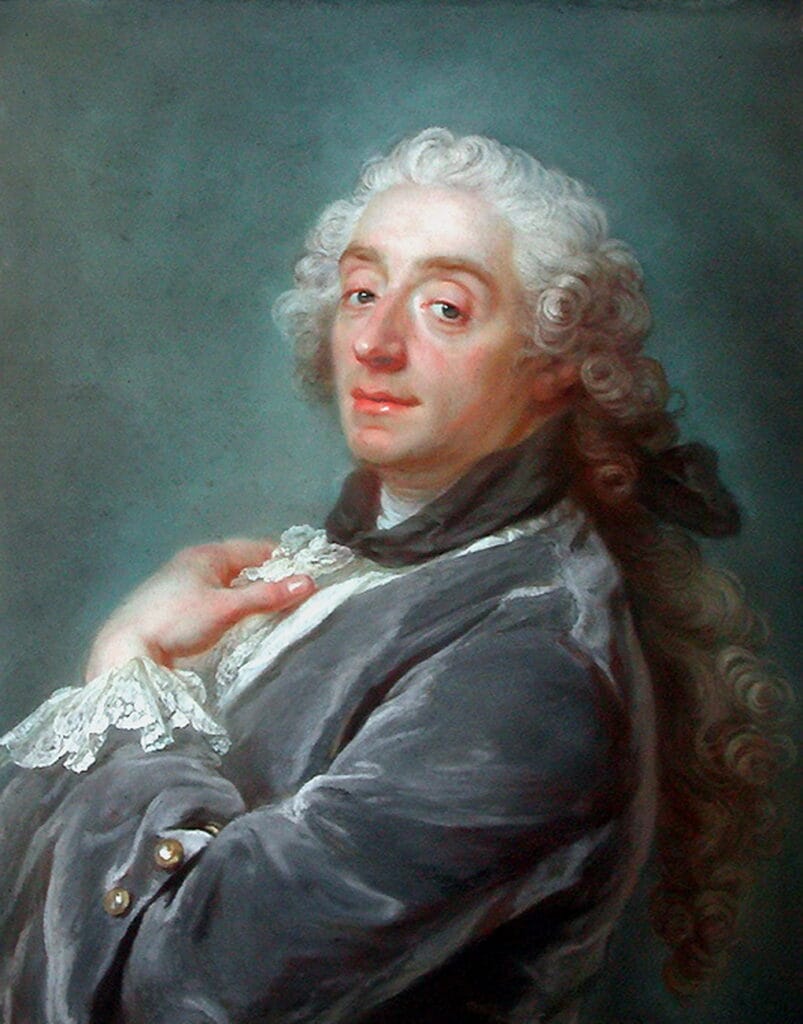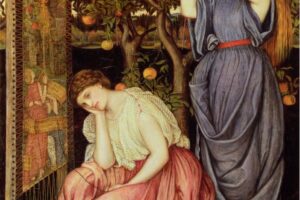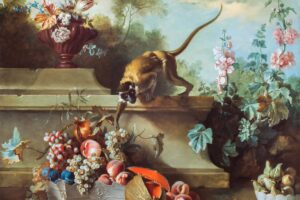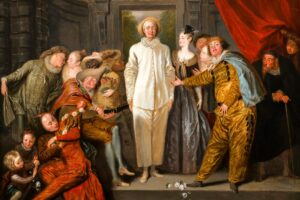Imagine finding yourself in a beautiful, leafy garden, where a secret unfolds before your eyes. That’s the enchanting scene François Boucher painted in 1748, titled “The Mysterious Basket.” As a master of the Rococo art style, Boucher loved to create charming, romantic, and often slightly mysterious scenes that draw you into their world.
This painting, shaped like an oval, feels like looking through a window into a private moment between two young people, surrounded by lush nature.
A Gift, a Gaze, and a Little Mystery
At the heart of the painting, we see a young man presenting something to a young woman, creating a moment of gentle suspense and curiosity.
- The Intent Young Man: On the right, a young man leans forward, his arm outstretched. He’s dressed in simple, rustic clothes – a blue and white shirt with rolled-up sleeves and reddish-brown breeches. His gaze is fixed on the young woman, full of earnestness and perhaps a touch of hope. In his hand, he offers a small, overflowing basket of colorful flowers to her. What makes it “mysterious” is that we don’t quite know if she’s accepted it yet, or what his full intentions are. He also holds a stick or scroll in his other hand, perhaps a shepherd’s staff or a love letter.
- The Thoughtful Young Woman: On the left, a beautiful young woman is seated on the ground, leaning back comfortably. She wears a flowing dress in earthy tones of brown and muted purple, with soft white sleeves. Her pose is relaxed, but her expression is thoughtful, even a little pensive. She holds her hand to her chin, as if considering the gift, or perhaps lost in thought. She seems calm, graceful, and holds an air of quiet contemplation.
More Than Just People: The Setting and Companions
Boucher’s genius shines in the details that fill the scene, making it feel alive and complete:
- The Faithful Companion: At the young man’s feet, a small, fluffy dog (perhaps a spaniel) looks up with loyal eyes. Dogs often symbolize faithfulness in art, adding to the gentle theme of affection.
- A Lush, Overgrown Garden: The background is a rich tapestry of green trees and flowing vines. On the left, partially hidden by foliage, is a classical stone urn or vase, adorned with carvings and draped with garlands. This hints at an old, perhaps forgotten garden, adding a romantic and slightly melancholic touch. The light filters through the leaves, creating dappled shadows and a soft, inviting atmosphere.
- The Hidden Secret: In the middle distance, behind the figures, you can spot more stone structures, perhaps parts of a ruined fountain or grotto, overgrown with greenery. This creates a sense of a hidden, intimate spot in nature. The oval shape of the canvas itself enhances the feeling of looking into a treasured, self-contained world.
The Story Within the Mystery
“The Mysterious Basket” is a beautiful exploration of budding romance, unspoken feelings, and the gentle art of courtship. The “mystery” isn’t a complex puzzle, but rather the quiet anticipation of whether a gift will be accepted, whether feelings are returned, and what the next moment might bring. Boucher captures this delicate tension with his signature grace and charm.
It’s a celebration of simple gestures, the beauty of nature, and the timeless dance between two hearts. Boucher invites us to ponder the scene, to imagine the words exchanged (or unsaid), and to appreciate the subtle magic of a shared, private moment in an idyllic world. like the woman: What’s in the basket, and what does it truly mean?
About Artist

François Boucher (1703–1770) was a French painter, a dominant figure of the Rococo art movement. He was the most celebrated artist of his time, serving as the official court painter to King Louis XV and working closely with the king’s chief mistress and art patron, Madame de Pompadour. His style is the very essence of Rococo: playful, sensuous, and highly decorative, focusing on mythological, allegorical, and pastoral scenes.
Artistic Style and Legacy
Boucher’s style is characterized by its lighthearted and charming nature, a direct contrast to the more somber and dramatic tones of the Baroque. His paintings are known for:
- Sinuous Lines and Curves: He preferred soft, flowing lines over the rigid geometry of earlier art.
- Pastel Color Palette: He used a delicate range of light blues, pinks, yellows, and greens.
- Playful Subject Matter: He often depicted scenes of love, mythology, and idyllic country life, often with a hint of eroticism.
Boucher’s artistic influence was immense. He was a master of many mediums, including tapestry design, and his work perfectly captured the refined tastes and luxurious lifestyle of the French aristocracy before the Revolution.
Notable Artwork
- La Toilette (c. 1742): A prime example of his intimate genre scenes, it depicts a woman at her dressing table, a subject that was popular in Rococo art.
- The Mysterious Basket (c. 1748): This is a work with a playful, ambiguous title, characteristic of his whimsical style.
- The Fountain of Love (c. 1748): A mythological and allegorical scene celebrating love, a classic Rococo subject.
- The Bird Catchers (c. 1748): Part of a series of idyllic pastoral scenes, this work exemplifies his charming depictions of country life.
- Spring (1755) from a series titled “The Four Seasons”: This work was created as part of a decorative set for Madame de Pompadour.
- Pastoral Scene (c. 1735): Boucher painted many similar scenes of shepherds and shepherdesses in idyllic settings, a cornerstone of his work.
- Madame de Pompadour (1756): One of his most famous portraits. It shows his patron in an opulent, relaxed setting, surrounded by objects that reflect her intellect and status.
- Les Sabots (c. 1768): Also known as “The Clogs,” this is another pastoral scene, showing a country girl in an idealized setting.
- A Lady on Her Day Bed (1743): This intimate portrait shows a woman in a relaxed, private moment, a popular theme in Rococo art that celebrated luxury and leisure.



